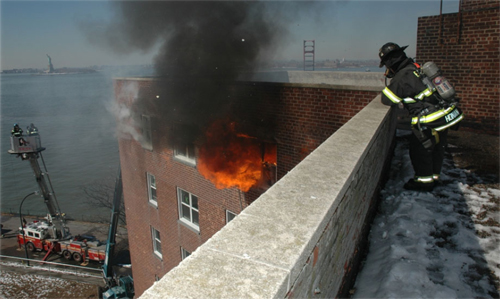Evaluating Firefighting Tactics Under Wind Driven Conditions
Art and Science of Firefighting
NIST has performed a wide range of research that can have a positive impact on the safety and effectiveness of firefighting operations. However, all too often, this information has not made it to front line firefighters. Dan Madrzykowski and Steve Kerber have made a concerted effort to address this issue and increase the day to day impact of NIST fire research. In the video overview of the wind driven fire research, Battalion Chief Jerry Tracy of the FDNY stated that this project was an effort to bridge the gap between the science and art of firefighting and get science to the street.
Research on Wind Driven Fires= Governors Island, New York City

Note: John Freeman Photo from NIST Report TN 1629
Understanding, Surviving, & Fighting Wind Driven Fires
This two DVD training package is based on NIST research conducted at the Building Fire Research Lab (BFRL) in Gaithersburg, MD and on Governors Island in New York city. The package contains:
- Written reports on the laboratory and field experiments
- Multiple videos of the experiments (from standard and thermal imaging video cameras)
- PowerPoint presentation on experimental procedures and results
- Video overview of the research and implications for fireground operations
While the reports and detailed video are tremendous resources, I believe that every firefighter in the United States would benefit from taking 86 minutes to watch the introductory video overview narrated by Battalion Chiefs Peter Van Dorpe (Chicago Fire Department), Jerry Tracy (Fire Department of New York), Dan Madrzykowski (NIST), and Steve Kerber (NIST). The overview presentation is divided into four segments:
- Introduction and the Chicago Fire Department Experience (BC Peter Van Dorpe)
- The FDNY Experience (BC Jerry Tracy)
- Laboratory Experiments (Dan Madrzykowski, PE)
- Governors Island Experiments (Steve Kerber)
- Conclusion (BCs Peter Van Dorpe and Jerry Tracy)
This video provides a powerful explanation of the potential danger of wind driven fires (in both high and low-rise structures) and illustrates how scientific research can have a positive impact on the safety and effectiveness of fireground operations. While some may discount the information presented because the research focused (to a large extent) on high-rise buildings, many of the lessons learned have applicability to a much wider range of buildings.
In the summary section of the overview video, BC Peter Van Dorpe made several interesting observations regarding the lessons he learned from this research:
In a high-rise building, you don’t ventilate until you have water on the fire based on potential for a wind driven fire and dramatic influence of wind and ventilation on fire behavior.
Consideration of the concept that the first water on a high-rise fire [in a non-sprinklered building] should be from the exterior based on the dramatic effect of relatively low flow application from the exterior in changing conditions from severe to controllable.
BC Jerry Tracy emphasized the importance of integrating the art and science of firefighting and the need for change. Credibility is critical, both from a scientific and operational perspective. He pointed to the importance of understanding impact of changes in ventilation profile on fire behavior in all types of fires and the potential benefits of alternative strategies and tactics.
How to Order
This two DVD set can be ordered from the United States Fire Administration (USFA) Web Site. However, orders are limited to a single set per organization.
Order Evaluating Firefighting Tactics Under Wind Driven Conditions
Information on this research is also available on the NIST Wind Driven Fire Research web page.
Action Steps
Get a copy of this training package and have a look at the overview video. Ask yourself how this information can be put to work in your environment? What application does this research have beyond high-rise buildings? How can we use this information to increase the safety and effectiveness of firefighting operations in single and multi-family dwellings and in commercial buildings?
CFBT-US on Twitter
In an effort to expand our network, CFBT-US is now on Twitter! Follow Chief Instructor Ed Hartin for information on fire behavior, incident information, photos and video for B-SAHF exercises. Check out the Twitter Portal for an overview video on Twitter and additional information on this social networking tool.
CFBT-US is exploring how to integrate Twitter with the CFBT Blog (and the blog with Twitter). Please share your feedback on the effectiveness and utility of this approach to information sharing.
Ed Hartin, MS, EFO, MIFireE, CFO
Tags: Add new tag, Extreme Fire Behavior, fire behavior, fire research, NIST, wind driven fire


